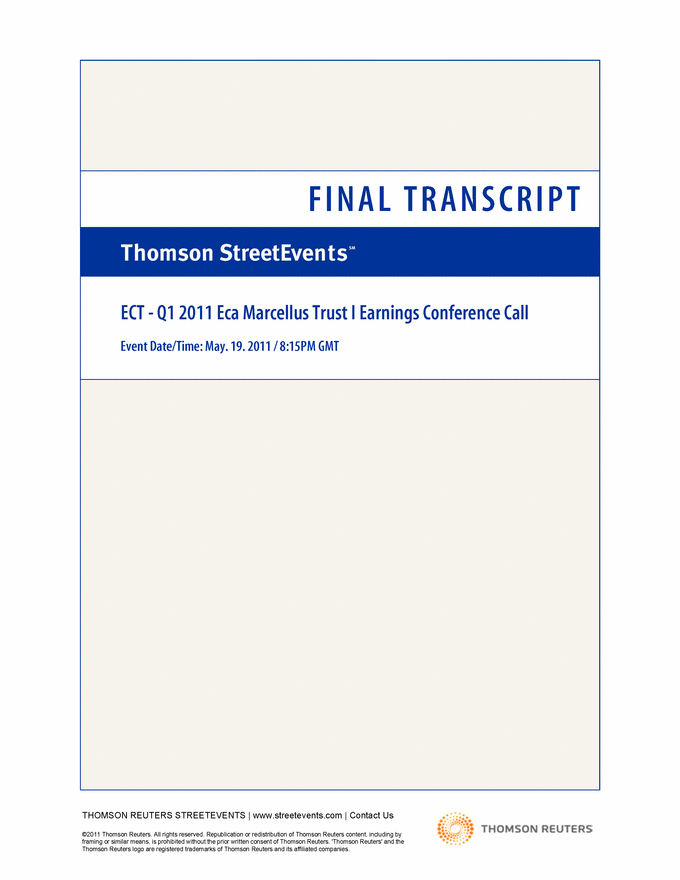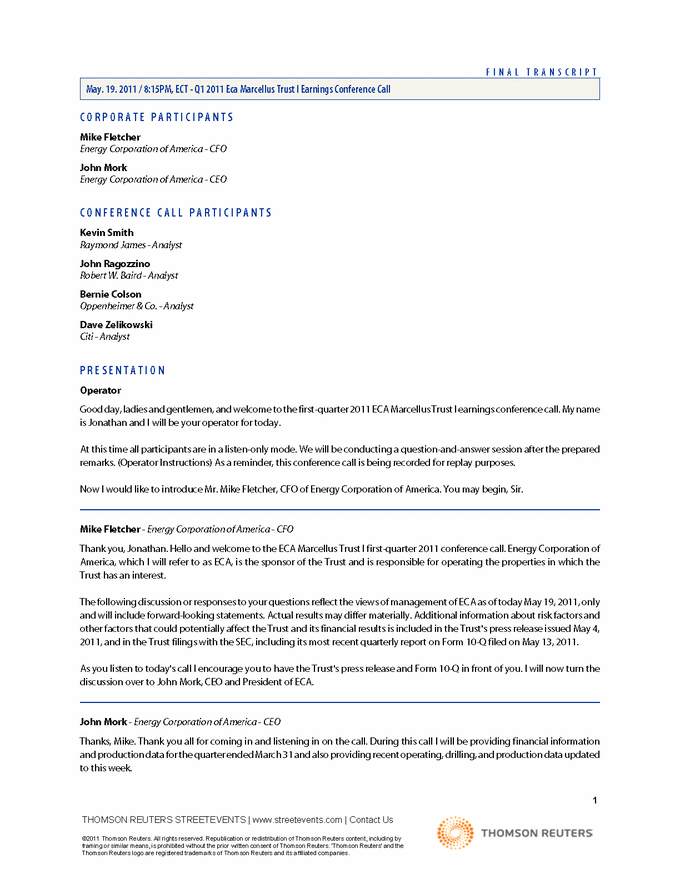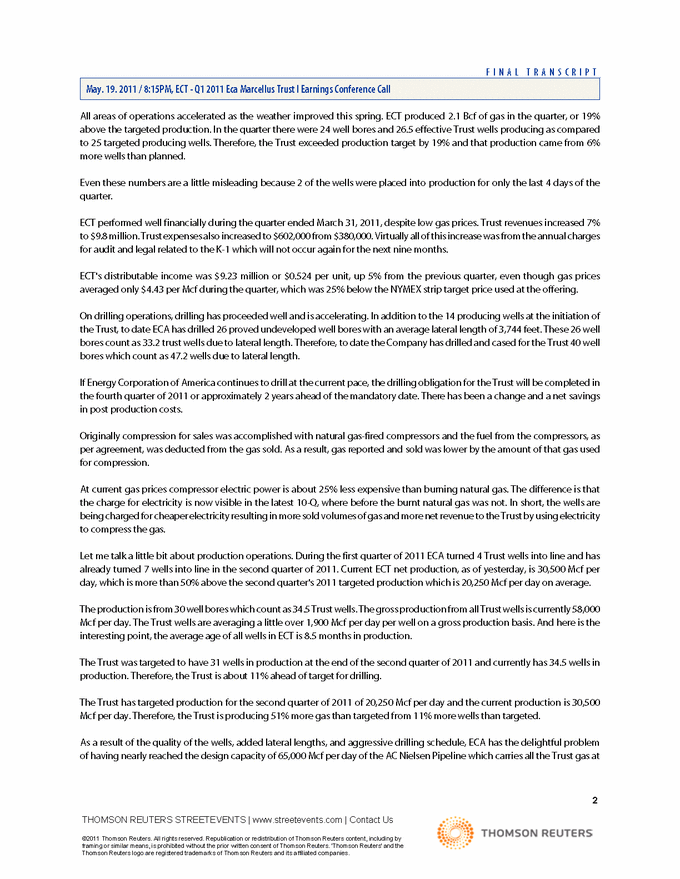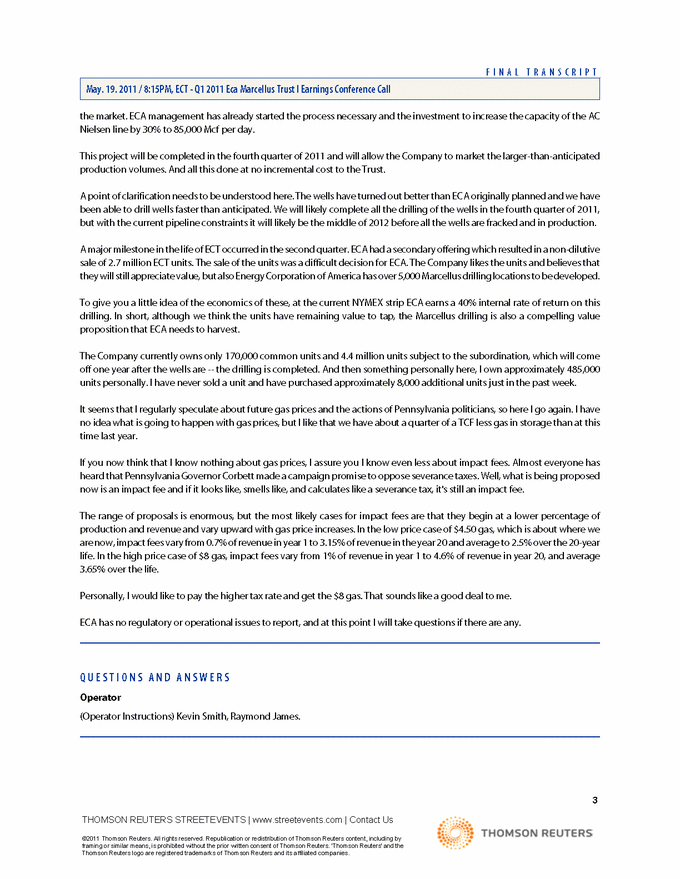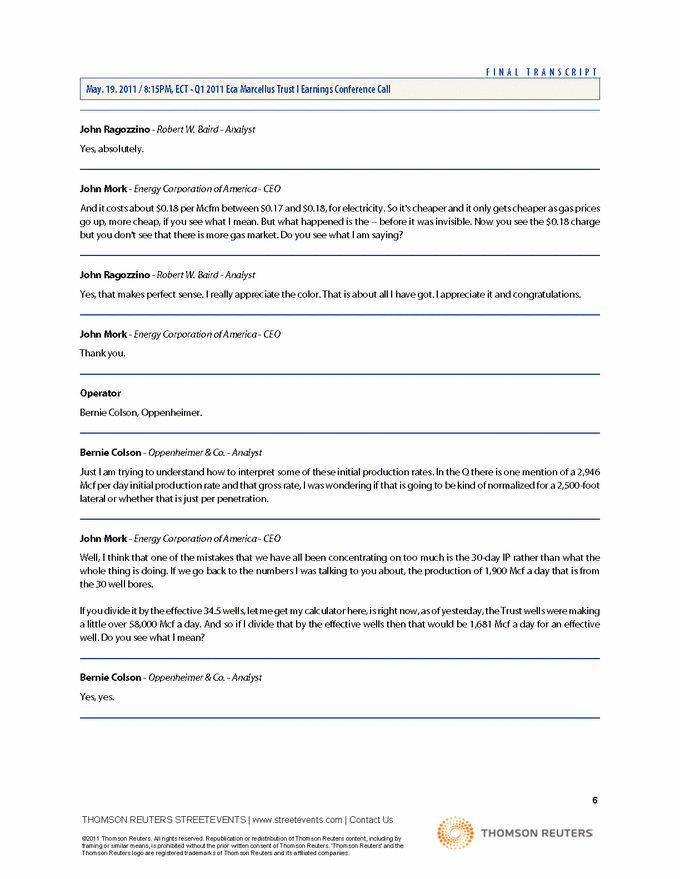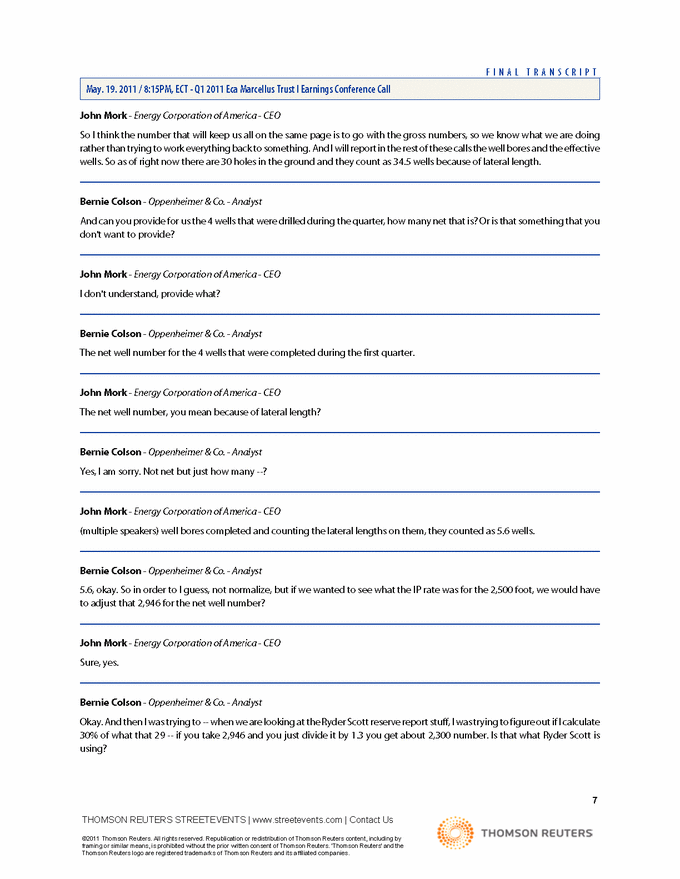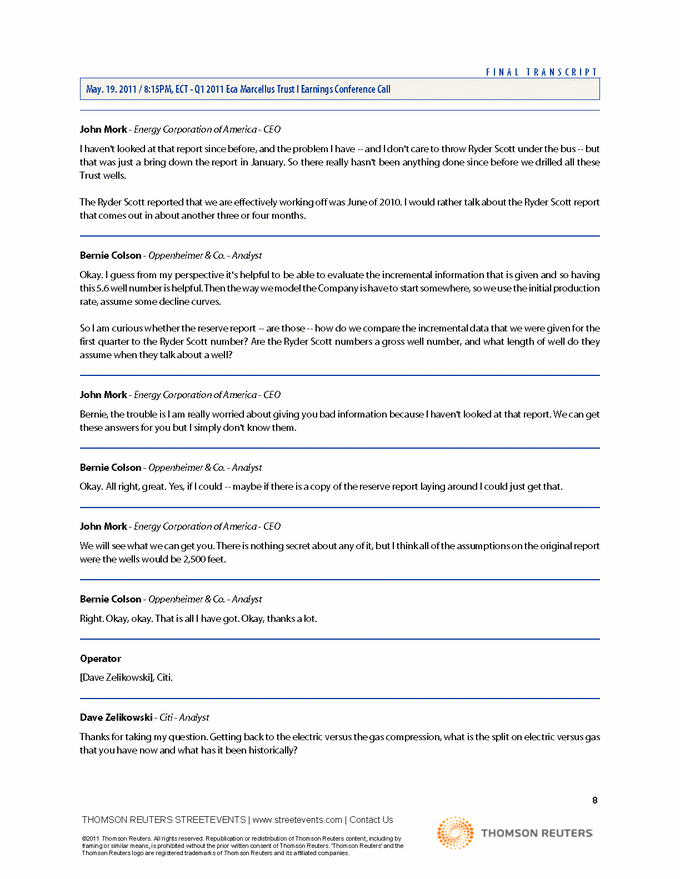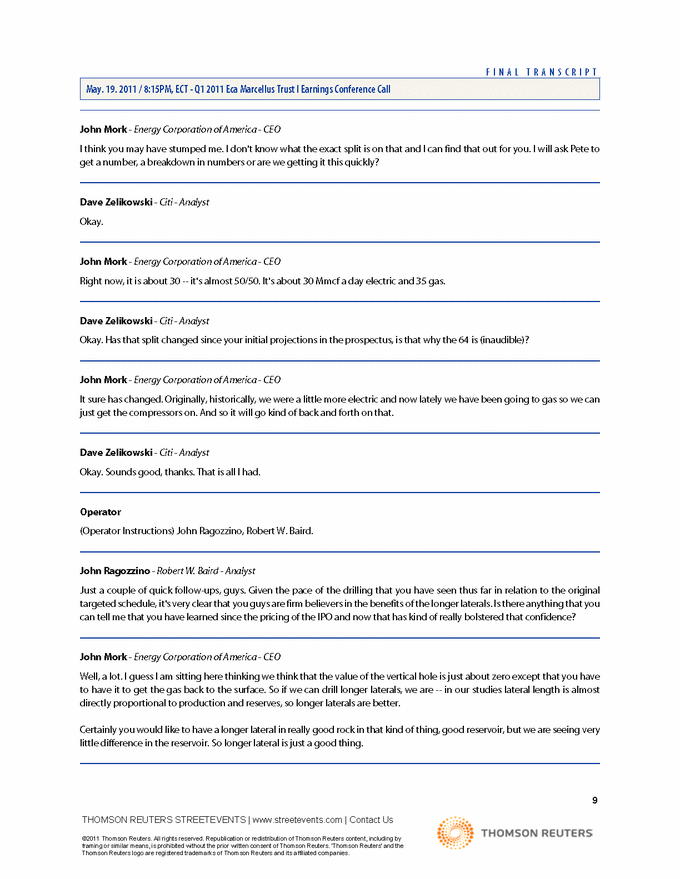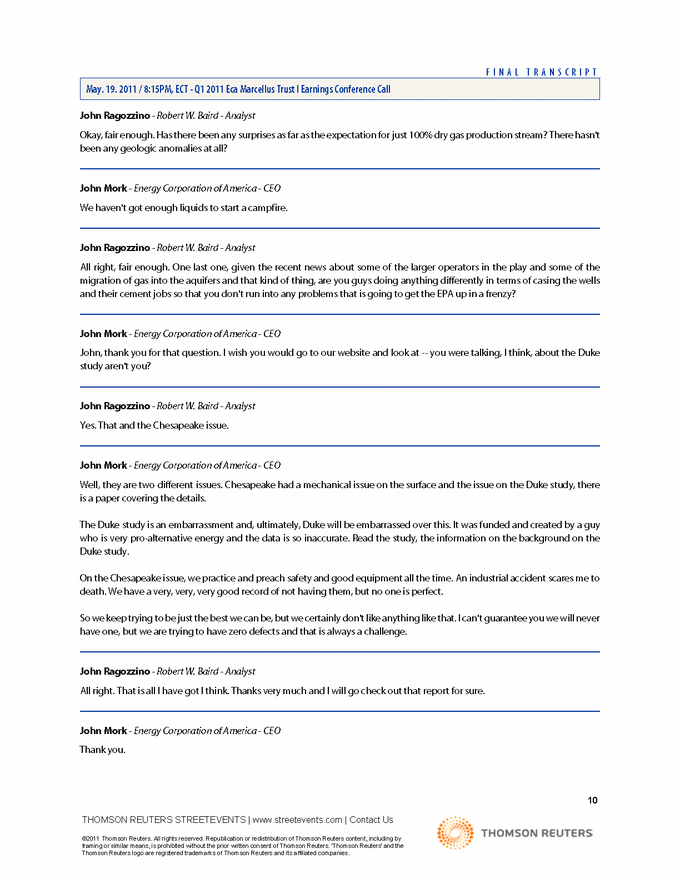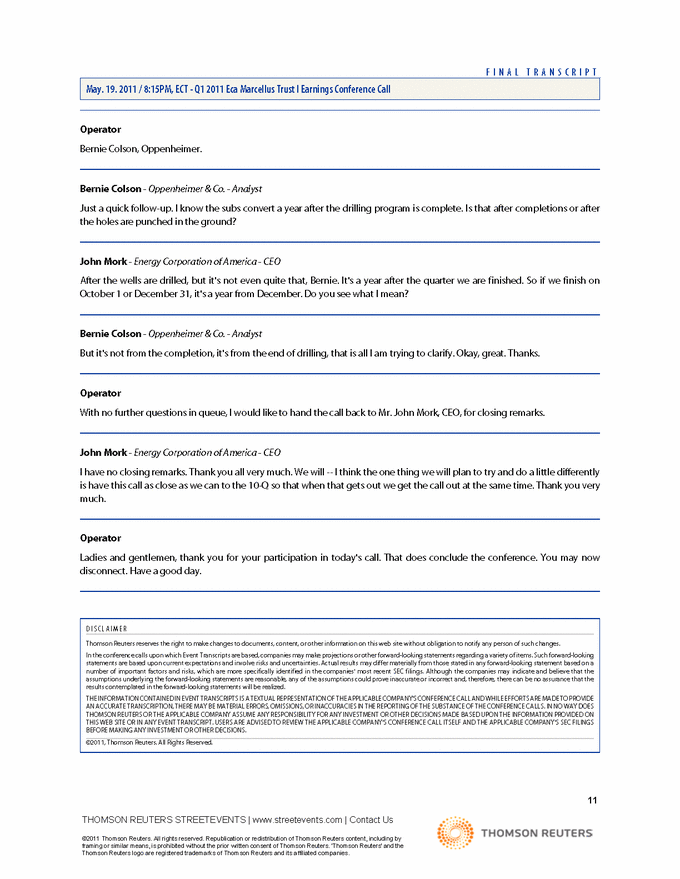Attached files
| file | filename |
|---|---|
| 8-K - CURRENT REPORT OF MATERIAL EVENTS OR CORPORATE CHANGES - ECA Marcellus Trust I | a11-13139_18k.htm |
Exhibit 99.1
|
|
FINAL TRANSCRIPT ECT - Q1 2011 Eca Marcellus Trust I Earnings Conference Call Event Date/Time: May. 19. 2011 / 8:15PM GMT THOMSON REUTERS STREETEVENTS | www.streetevents.com | Contact Us ©2011 Thomson Reuters. All rights reserved. Republication or redistribution of Thomson Reuters content, including by framing or similar means, is prohibited without the prior written consent of Thomson Reuters. 'Thomson Reuters' and the Thomson Reuters logo are registered trademarks of Thomson Reuters and its affiliated companies. |
|
|
C O R P O R A T E P A R T I C I P A N T S Mike Fletcher Energy Corporation of America - CFO John Mork Energy Corporation of America - CEO C O N F E R E N C E C A L L P A R T I C I P A N T S Kevin Smith Raymond James - Analyst John Ragozzino Robert W. Baird - Analyst Bernie Colson Oppenheimer & Co. - Analyst Dave Zelikowski Citi - Analyst P R E S E N T A T I O N Operator Good day, ladies and gentlemen, and welcome to the first-quarter 2011 ECA Marcellus Trust I earnings conference call. My name is Jonathan and I will be your operator for today. At this time all participants are in a listen-only mode. We will be conducting a question-and-answer session after the prepared remarks. (Operator Instructions) As a reminder, this conference call is being recorded for replay purposes. Now I would like to introduce Mr. Mike Fletcher, CFO of Energy Corporation of America. You may begin, Sir. Mike Fletcher - Energy Corporation of America - CFO Thank you, Jonathan. Hello and welcome to the ECA Marcellus Trust I first-quarter 2011 conference call. Energy Corporation of America, which I will refer to as ECA, is the sponsor of the Trust and is responsible for operating the properties in which the Trust has an interest. The following discussion or responses to your questions reflect the views of management of ECA as of today May 19, 2011, only and will include forward-looking statements. Actual results may differ materially. Additional information about risk factors and other factors that could potentially affect the Trust and its financial results is included in the Trust's press release issued May 4, 2011, and in the Trust filings with the SEC, including its most recent quarterly report on Form 10-Q filed on May 13, 2011. As you listen to today's call I encourage you to have the Trust's press release and Form 10-Q in front of you. I will now turn the discussion over to John Mork, CEO and President of ECA. John Mork - Energy Corporation of America - CEO Thanks, Mike. Thank you all for coming in and listening in on the call. During this call I will be providing financial information and production data for the quarter ended March 31 and also providing recent operating, drilling, and production data updated to this week. 1 THOMSON REUTERS STREETEVENTS | www.streetevents.com | Contact Us ©2011 Thomson Reuters. All rights reserved. Republication or redistribution of Thomson Reuters content, including by framing or similar means, is prohibited without the prior written consent of Thomson Reuters. 'Thomson Reuters' and the Thomson Reuters logo are registered trademarks of Thomson Reuters and its affiliated companies. F I N A L T R A N S C R I P T May. 19. 2011 / 8:15PM, ECT - Q1 2011 Eca Marcellus Trust I Earnings Conference Call |
|
|
All areas of operations accelerated as the weather improved this spring. ECT produced 2.1 Bcf of gas in the quarter, or 19% above the targeted production. In the quarter there were 24 well bores and 26.5 effective Trust wells producing as compared to 25 targeted producing wells. Therefore, the Trust exceeded production target by 19% and that production came from 6% more wells than planned. Even these numbers are a little misleading because 2 of the wells were placed into production for only the last 4 days of the quarter. ECT performed well financially during the quarter ended March 31, 2011, despite low gas prices. Trust revenues increased 7% to $9.8 million. Trust expenses also increased to $602,000 from $380,000. Virtually all of this increase was from the annual charges for audit and legal related to the K-1 which will not occur again for the next nine months. ECT's distributable income was $9.23 million or $0.524 per unit, up 5% from the previous quarter, even though gas prices averaged only $4.43 per Mcf during the quarter, which was 25% below the NYMEX strip target price used at the offering. On drilling operations, drilling has proceeded well and is accelerating. In addition to the 14 producing wells at the initiation of the Trust, to date ECA has drilled 26 proved undeveloped well bores with an average lateral length of 3,744 feet. These 26 well bores count as 33.2 trust wells due to lateral length. Therefore, to date the Company has drilled and cased for the Trust 40 well bores which count as 47.2 wells due to lateral length. If Energy Corporation of America continues to drill at the current pace, the drilling obligation for the Trust will be completed in the fourth quarter of 2011 or approximately 2 years ahead of the mandatory date. There has been a change and a net savings in post production costs. Originally compression for sales was accomplished with natural gas-fired compressors and the fuel from the compressors, as per agreement, was deducted from the gas sold. As a result, gas reported and sold was lower by the amount of that gas used for compression. At current gas prices compressor electric power is about 25% less expensive than burning natural gas. The difference is that the charge for electricity is now visible in the latest 10-Q, where before the burnt natural gas was not. In short, the wells are being charged for cheaper electricity resulting in more sold volumes of gas and more net revenue to the Trust by using electricity to compress the gas. Let me talk a little bit about production operations. During the first quarter of 2011 ECA turned 4 Trust wells into line and has already turned 7 wells into line in the second quarter of 2011. Current ECT net production, as of yesterday, is 30,500 Mcf per day, which is more than 50% above the second quarter's 2011 targeted production which is 20,250 Mcf per day on average. The production is from 30 well bores which count as 34.5 Trust wells. The gross production from all Trust wells is currently 58,000 Mcf per day. The Trust wells are averaging a little over 1,900 Mcf per day per well on a gross production basis. And here is the interesting point, the average age of all wells in ECT is 8.5 months in production. The Trust was targeted to have 31 wells in production at the end of the second quarter of 2011 and currently has 34.5 wells in production. Therefore, the Trust is about 11% ahead of target for drilling. The Trust has targeted production for the second quarter of 2011 of 20,250 Mcf per day and the current production is 30,500 Mcf per day. Therefore, the Trust is producing 51% more gas than targeted from 11% more wells than targeted. As a result of the quality of the wells, added lateral lengths, and aggressive drilling schedule, ECA has the delightful problem of having nearly reached the design capacity of 65,000 Mcf per day of the AC Nielsen Pipeline which carries all the Trust gas at 2 THOMSON REUTERS STREETEVENTS | www.streetevents.com | Contact Us ©2011 Thomson Reuters. All rights reserved. Republication or redistribution of Thomson Reuters content, including by framing or similar means, is prohibited without the prior written consent of Thomson Reuters. 'Thomson Reuters' and the Thomson Reuters logo are registered trademarks of Thomson Reuters and its affiliated companies. F I N A L T R A N S C R I P T May. 19. 2011 / 8:15PM, ECT - Q1 2011 Eca Marcellus Trust I Earnings Conference Call |
|
|
the market. ECA management has already started the process necessary and the investment to increase the capacity of the AC Nielsen line by 30% to 85,000 Mcf per day. This project will be completed in the fourth quarter of 2011 and will allow the Company to market the larger-than-anticipated production volumes. And all this done at no incremental cost to the Trust. A point of clarification needs to be understood here. The wells have turned out better than ECA originally planned and we have been able to drill wells faster than anticipated. We will likely complete all the drilling of the wells in the fourth quarter of 2011, but with the current pipeline constraints it will likely be the middle of 2012 before all the wells are fracked and in production. A major milestone in the life of ECT occurred in the second quarter. ECA had a secondary offering which resulted in a non-dilutive sale of 2.7 million ECT units. The sale of the units was a difficult decision for ECA. The Company likes the units and believes that they will still appreciate value, but also Energy Corporation of America has over 5,000 Marcellus drilling locations to be developed. To give you a little idea of the economics of these, at the current NYMEX strip ECA earns a 40% internal rate of return on this drilling. In short, although we think the units have remaining value to tap, the Marcellus drilling is also a compelling value proposition that ECA needs to harvest. The Company currently owns only 170,000 common units and 4.4 million units subject to the subordination, which will come off one year after the wells are -- the drilling is completed. And then something personally here, I own approximately 485,000 units personally. I have never sold a unit and have purchased approximately 8,000 additional units just in the past week. It seems that I regularly speculate about future gas prices and the actions of Pennsylvania politicians, so here I go again. I have no idea what is going to happen with gas prices, but I like that we have about a quarter of a TCF less gas in storage than at this time last year. If you now think that I know nothing about gas prices, I assure you I know even less about impact fees. Almost everyone has heard that Pennsylvania Governor Corbett made a campaign promise to oppose severance taxes. Well, what is being proposed now is an impact fee and if it looks like, smells like, and calculates like a severance tax, it's still an impact fee. The range of proposals is enormous, but the most likely cases for impact fees are that they begin at a lower percentage of production and revenue and vary upward with gas price increases. In the low price case of $4.50 gas, which is about where we are now, impact fees vary from 0.7% of revenue in year 1 to 3.15% of revenue in the year 20 and average to 2.5% over the 20-year life. In the high price case of $8 gas, impact fees vary from 1% of revenue in year 1 to 4.6% of revenue in year 20, and average 3.65% over the life. Personally, I would like to pay the higher tax rate and get the $8 gas. That sounds like a good deal to me. ECA has no regulatory or operational issues to report, and at this point I will take questions if there are any. Q U E S T I O N S A N D A N S W E R S Operator (Operator Instructions) Kevin Smith, Raymond James. 3 THOMSON REUTERS STREETEVENTS | www.streetevents.com | Contact Us ©2011 Thomson Reuters. All rights reserved. Republication or redistribution of Thomson Reuters content, including by framing or similar means, is prohibited without the prior written consent of Thomson Reuters. 'Thomson Reuters' and the Thomson Reuters logo are registered trademarks of Thomson Reuters and its affiliated companies. F I N A L T R A N S C R I P T May. 19. 2011 / 8:15PM, ECT - Q1 2011 Eca Marcellus Trust I Earnings Conference Call |
|
|
Kevin Smith - Raymond James - Analyst Good afternoon, gentlemen. John Mork - Energy Corporation of America - CEO Yes, Kevin. How are you? Kevin Smith - Raymond James - Analyst Doing well and congrats on the production results. It sounds like the wells are coming in really strong. I guess my first question really is you touched on the design capacity of the AC Nielsen line. When do you think you will reach capacity there, and on a near-term basis how is that going to impact your schedule of putting wells online? John Mork - Energy Corporation of America - CEO We anticipate that we will remain well ahead of the production schedule. We have one more well to frac in this quarter and then we will frac 3 or 4 wells next quarter, so we will stay on this. The construction will be working in the middle of the summer and in the fourth quarter we will have it on. I don't think it will affect the schedule much. Kevin Smith - Raymond James - Analyst Okay. So there is not going to be a prolonged period where you are not able to put any wells or like a 3-month period or anything like that? John Mork - Energy Corporation of America - CEO Don't see anything like that. Kevin Smith - Raymond James - Analyst Okay, great. And then, other than that decline rates, EUR still coming in as expected? John Mork - Energy Corporation of America - CEO We aren't calculating any EURs. We haven't had anything done since last quarter with Ryder Scott so the next thing we will be doing is at year-end. Kevin Smith - Raymond James - Analyst Okay. That is all of the questions I had. Thanks, gentlemen. Operator John Ragozzino, Robert W. Baird. 4 THOMSON REUTERS STREETEVENTS | www.streetevents.com | Contact Us ©2011 Thomson Reuters. All rights reserved. Republication or redistribution of Thomson Reuters content, including by framing or similar means, is prohibited without the prior written consent of Thomson Reuters. 'Thomson Reuters' and the Thomson Reuters logo are registered trademarks of Thomson Reuters and its affiliated companies. F I N A L T R A N S C R I P T May. 19. 2011 / 8:15PM, ECT - Q1 2011 Eca Marcellus Trust I Earnings Conference Call |
|
|
John Ragozzino - Robert W. Baird - Analyst Good afternoon, guys. Quick question just on the gathering system upgrade. Was the previous expectation to have that completed in August or am I thinking about the firm transportation agreement? I just want to make sure I have got my details straight here. John Mork - Energy Corporation of America - CEO I don't think we had any plan for an upgrade in August because we weren't planning for an upgrade until a couple of months ago, so it's since the last phone calls. So that must have been something else. I am just not sure what you are talking about. John Ragozzino - Robert W. Baird - Analyst Okay, I apologize. I think it's related to the signing of the firm transportation agreement that you had. Let's just move right along then. Looking to the G&A expense, you guys gave us a pretty good understanding of what drove the higher levels in the first quarter. So when I think about the remainder of 2011 -- and obviously you are not going to see some of K-1 filing expenses that are going to be in there, but what about the remainder of the admin fee? You have got another $75,000 that have to get expensed over the course of the year. Are you going to see that over the course of the two quarters or are you going to lump it into one? John Mork - Energy Corporation of America - CEO Well, I am sure it will be over two quarters. I wish the trustee were on here because that is not us, you see what I mean. John Ragozzino - Robert W. Baird - Analyst Yes. And then for next year in 2012, do you expect to see a similar type of spike in the G&A expense for the first quarter? John Mork - Energy Corporation of America - CEO I would think so. I am looking at this and there were legal fees of about $70,000 and then audit fees of -- no, excuse me, there were legal fees of $110,000, tax fees of $38,000, audit fees of $95,000, and some other fees of $18,000 -- I don't even know what those are. That is what covered up this period and so I would imagine we would have those probably again. John Ragozzino - Robert W. Baird - Analyst Okay. And then you talked a little bit about the post-production service costs and the impact of using the electric compression versus the natural gas powered compression. You said that it's 25% cheaper; do you care to quantify exactly if you had an implied per-unit type of expense that you would see on each compression? John Mork - Energy Corporation of America - CEO What was happening before -- when we are compressing with natural gas it costs about $0.25 per Mcf of gas use to compress the gas. Do you see what I am saying? 5 THOMSON REUTERS STREETEVENTS | www.streetevents.com | Contact Us ©2011 Thomson Reuters. All rights reserved. Republication or redistribution of Thomson Reuters content, including by framing or similar means, is prohibited without the prior written consent of Thomson Reuters. 'Thomson Reuters' and the Thomson Reuters logo are registered trademarks of Thomson Reuters and its affiliated companies. F I N A L T R A N S C R I P T May. 19. 2011 / 8:15PM, ECT - Q1 2011 Eca Marcellus Trust I Earnings Conference Call |
|
|
John Ragozzino - Robert W. Baird - Analyst Yes, absolutely. John Mork - Energy Corporation of America - CEO And it costs about $0.18 per Mcfm between $0.17 and $0.18, for electricity. So it's cheaper and it only gets cheaper as gas prices go up, more cheap, if you see what I mean. But what happened is the -- before it was invisible. Now you see the $0.18 charge but you don't see that there is more gas market. Do you see what I am saying? John Ragozzino - Robert W. Baird - Analyst Yes, that makes perfect sense. I really appreciate the color. That is about all I have got. I appreciate it and congratulations. John Mork - Energy Corporation of America - CEO Thank you. Operator Bernie Colson, Oppenheimer. Bernie Colson - Oppenheimer & Co. - Analyst Just I am trying to understand how to interpret some of these initial production rates. In the Q there is one mention of a 2,946 Mcf per day initial production rate and that gross rate, I was wondering if that is going to be kind of normalized for a 2,500-foot lateral or whether that is just per penetration. John Mork - Energy Corporation of America - CEO Well, I think that one of the mistakes that we have all been concentrating on too much is the 30-day IP rather than what the whole thing is doing. If we go back to the numbers I was talking to you about, the production of 1,900 Mcf a day that is from the 30 well bores. If you divide it by the effective 34.5 wells, let me get my calculator here, is right now, as of yesterday, the Trust wells were making a little over 58,000 Mcf a day. And so if I divide that by the effective wells then that would be 1,681 Mcf a day for an effective well. Do you see what I mean? Bernie Colson - Oppenheimer & Co. - Analyst Yes, yes. 6 THOMSON REUTERS STREETEVENTS | www.streetevents.com | Contact Us ©2011 Thomson Reuters. All rights reserved. Republication or redistribution of Thomson Reuters content, including by framing or similar means, is prohibited without the prior written consent of Thomson Reuters. 'Thomson Reuters' and the Thomson Reuters logo are registered trademarks of Thomson Reuters and its affiliated companies. F I N A L T R A N S C R I P T May. 19. 2011 / 8:15PM, ECT - Q1 2011 Eca Marcellus Trust I Earnings Conference Call |
|
|
John Mork - Energy Corporation of America - CEO So I think the number that will keep us all on the same page is to go with the gross numbers, so we know what we are doing rather than trying to work everything back to something. And I will report in the rest of these calls the well bores and the effective wells. So as of right now there are 30 holes in the ground and they count as 34.5 wells because of lateral length. Bernie Colson - Oppenheimer & Co. - Analyst And can you provide for us the 4 wells that were drilled during the quarter, how many net that is? Or is that something that you don't want to provide? John Mork - Energy Corporation of America - CEO I don't understand, provide what? Bernie Colson - Oppenheimer & Co. - Analyst The net well number for the 4 wells that were completed during the first quarter. John Mork - Energy Corporation of America - CEO The net well number, you mean because of lateral length? Bernie Colson - Oppenheimer & Co. - Analyst Yes, I am sorry. Not net but just how many --? John Mork - Energy Corporation of America - CEO (multiple speakers) well bores completed and counting the lateral lengths on them, they counted as 5.6 wells. Bernie Colson - Oppenheimer & Co. - Analyst 5.6, okay. So in order to I guess, not normalize, but if we wanted to see what the IP rate was for the 2,500 foot, we would have to adjust that 2,946 for the net well number? John Mork - Energy Corporation of America - CEO Sure, yes. Bernie Colson - Oppenheimer & Co. - Analyst Okay. And then I was trying to -- when we are looking at the Ryder Scott reserve report stuff, I was trying to figure out if I calculate 30% of what that 29 -- if you take 2,946 and you just divide it by 1.3 you get about 2,300 number. Is that what Ryder Scott is using? 7 THOMSON REUTERS STREETEVENTS | www.streetevents.com | Contact Us ©2011 Thomson Reuters. All rights reserved. Republication or redistribution of Thomson Reuters content, including by framing or similar means, is prohibited without the prior written consent of Thomson Reuters. 'Thomson Reuters' and the Thomson Reuters logo are registered trademarks of Thomson Reuters and its affiliated companies. F I N A L T R A N S C R I P T May. 19. 2011 / 8:15PM, ECT - Q1 2011 Eca Marcellus Trust I Earnings Conference Call |
|
|
John Mork - Energy Corporation of America - CEO I haven't looked at that report since before, and the problem I have -- and I don't care to throw Ryder Scott under the bus -- but that was just a bring down the report in January. So there really hasn't been anything done since before we drilled all these Trust wells. The Ryder Scott reported that we are effectively working off was June of 2010. I would rather talk about the Ryder Scott report that comes out in about another three or four months. Bernie Colson - Oppenheimer & Co. - Analyst Okay. I guess from my perspective it's helpful to be able to evaluate the incremental information that is given and so having this 5.6 well number is helpful. Then the way we model the Company is have to start somewhere, so we use the initial production rate, assume some decline curves. So I am curious whether the reserve report -- are those -- how do we compare the incremental data that we were given for the first quarter to the Ryder Scott number? Are the Ryder Scott numbers a gross well number, and what length of well do they assume when they talk about a well? John Mork - Energy Corporation of America - CEO Bernie, the trouble is I am really worried about giving you bad information because I haven't looked at that report. We can get these answers for you but I simply don't know them. Bernie Colson - Oppenheimer & Co. - Analyst Okay. All right, great. Yes, if I could -- maybe if there is a copy of the reserve report laying around I could just get that. John Mork - Energy Corporation of America - CEO We will see what we can get you. There is nothing secret about any of it, but I think all of the assumptions on the original report were the wells would be 2,500 feet. Bernie Colson - Oppenheimer & Co. - Analyst Right. Okay, okay. That is all I have got. Okay, thanks a lot. Operator [Dave Zelikowski], Citi. Dave Zelikowski - Citi - Analyst Thanks for taking my question. Getting back to the electric versus the gas compression, what is the split on electric versus gas that you have now and what has it been historically? 8 THOMSON REUTERS STREETEVENTS | www.streetevents.com | Contact Us ©2011 Thomson Reuters. All rights reserved. Republication or redistribution of Thomson Reuters content, including by framing or similar means, is prohibited without the prior written consent of Thomson Reuters. 'Thomson Reuters' and the Thomson Reuters logo are registered trademarks of Thomson Reuters and its affiliated companies. F I N A L T R A N S C R I P T May. 19. 2011 / 8:15PM, ECT - Q1 2011 Eca Marcellus Trust I Earnings Conference Call |
|
|
John Mork - Energy Corporation of America - CEO I think you may have stumped me. I don't know what the exact split is on that and I can find that out for you. I will ask Pete to get a number, a breakdown in numbers or are we getting it this quickly? Dave Zelikowski - Citi - Analyst Okay. John Mork - Energy Corporation of America - CEO Right now, it is about 30 -- it's almost 50/50. It's about 30 Mmcf a day electric and 35 gas. Dave Zelikowski - Citi - Analyst Okay. Has that split changed since your initial projections in the prospectus, is that why the 64 is (inaudible)? John Mork - Energy Corporation of America - CEO It sure has changed. Originally, historically, we were a little more electric and now lately we have been going to gas so we can just get the compressors on. And so it will go kind of back and forth on that. Dave Zelikowski - Citi - Analyst Okay. Sounds good, thanks. That is all I had. Operator (Operator Instructions) John Ragozzino, Robert W. Baird. John Ragozzino - Robert W. Baird - Analyst Just a couple of quick follow-ups, guys. Given the pace of the drilling that you have seen thus far in relation to the original targeted schedule, it's very clear that you guys are firm believers in the benefits of the longer laterals. Is there anything that you can tell me that you have learned since the pricing of the IPO and now that has kind of really bolstered that confidence? John Mork - Energy Corporation of America - CEO Well, a lot. I guess I am sitting here thinking we think that the value of the vertical hole is just about zero except that you have to have it to get the gas back to the surface. So if we can drill longer laterals, we are -- in our studies lateral length is almost directly proportional to production and reserves, so longer laterals are better. Certainly you would like to have a longer lateral in really good rock in that kind of thing, good reservoir, but we are seeing very little difference in the reservoir. So longer lateral is just a good thing. 9 THOMSON REUTERS STREETEVENTS | www.streetevents.com | Contact Us ©2011 Thomson Reuters. All rights reserved. Republication or redistribution of Thomson Reuters content, including by framing or similar means, is prohibited without the prior written consent of Thomson Reuters. 'Thomson Reuters' and the Thomson Reuters logo are registered trademarks of Thomson Reuters and its affiliated companies. F I N A L T R A N S C R I P T May. 19. 2011 / 8:15PM, ECT - Q1 2011 Eca Marcellus Trust I Earnings Conference Call |
|
|
John Ragozzino - Robert W. Baird - Analyst Okay, fair enough. Has there been any surprises as far as the expectation for just 100% dry gas production stream? There hasn't been any geologic anomalies at all? John Mork - Energy Corporation of America - CEO We haven't got enough liquids to start a campfire. John Ragozzino - Robert W. Baird - Analyst All right, fair enough. One last one, given the recent news about some of the larger operators in the play and some of the migration of gas into the aquifers and that kind of thing, are you guys doing anything differently in terms of casing the wells and their cement jobs so that you don't run into any problems that is going to get the EPA up in a frenzy? John Mork - Energy Corporation of America - CEO John, thank you for that question. I wish you would go to our website and look at -- you were talking, I think, about the Duke study aren't you? John Ragozzino - Robert W. Baird - Analyst Yes. That and the Chesapeake issue. John Mork - Energy Corporation of America - CEO Well, they are two different issues. Chesapeake had a mechanical issue on the surface and the issue on the Duke study, there is a paper covering the details. The Duke study is an embarrassment and, ultimately, Duke will be embarrassed over this. It was funded and created by a guy who is very pro-alternative energy and the data is so inaccurate. Read the study, the information on the background on the Duke study. On the Chesapeake issue, we practice and preach safety and good equipment all the time. An industrial accident scares me to death. We have a very, very, very good record of not having them, but no one is perfect. So we keep trying to be just the best we can be, but we certainly don't like anything like that. I can't guarantee you we will never have one, but we are trying to have zero defects and that is always a challenge. John Ragozzino - Robert W. Baird - Analyst All right. That is all I have got I think. Thanks very much and I will go check out that report for sure. John Mork - Energy Corporation of America - CEO Thank you. 10 THOMSON REUTERS STREETEVENTS | www.streetevents.com | Contact Us ©2011 Thomson Reuters. All rights reserved. Republication or redistribution of Thomson Reuters content, including by framing or similar means, is prohibited without the prior written consent of Thomson Reuters. 'Thomson Reuters' and the Thomson Reuters logo are registered trademarks of Thomson Reuters and its affiliated companies. F I N A L T R A N S C R I P T May. 19. 2011 / 8:15PM, ECT - Q1 2011 Eca Marcellus Trust I Earnings Conference Call |
|
|
Operator Bernie Colson, Oppenheimer. Bernie Colson - Oppenheimer & Co. - Analyst Just a quick follow-up. I know the subs convert a year after the drilling program is complete. Is that after completions or after the holes are punched in the ground? John Mork - Energy Corporation of America - CEO After the wells are drilled, but it's not even quite that, Bernie. It's a year after the quarter we are finished. So if we finish on October 1 or December 31, it's a year from December. Do you see what I mean? Bernie Colson - Oppenheimer & Co. - Analyst But it's not from the completion, it's from the end of drilling, that is all I am trying to clarify. Okay, great. Thanks. Operator With no further questions in queue, I would like to hand the call back to Mr. John Mork, CEO, for closing remarks. John Mork - Energy Corporation of America - CEO I have no closing remarks. Thank you all very much. We will -- I think the one thing we will plan to try and do a little differently is have this call as close as we can to the 10-Q so that when that gets out we get the call out at the same time. Thank you very much. Operator Ladies and gentlemen, thank you for your participation in today's call. That does conclude the conference. You may now disconnect. Have a good day. D I S C L A I M E R Thomson Reuters reserves the right to make changes to documents, content, or other information on this web site without obligation to notify any person of such changes. In the conference calls upon which Event Transcripts are based, companies may make projections or other forward-looking statements regarding a variety of items. Such forward-looking statements are based upon current expectations and involve risks and uncertainties. Actual results may differ materially from those stated in any forward-looking statement based on a number of important factors and risks, which are more specifically identified in the companies' most recent SEC filings. Although the companies may indicate and believe that the assumptions underlying the forward-looking statements are reasonable, any of the assumptions could prove inaccurate or incorrect and, therefore, there can be no assurance that the results contemplated in the forward-looking statements will be realized. THE INFORMATION CONTAINED IN EVENT TRANSCRIPTS IS A TEXTUAL REPRESENTATION OF THE APPLICABLE COMPANY'S CONFERENCE CALL AND WHILE EFFORTS ARE MADE TO PROVIDE AN ACCURATE TRANSCRIPTION, THERE MAY BE MATERIAL ERRORS, OMISSIONS, OR INACCURACIES IN THE REPORTING OF THE SUBSTANCE OF THE CONFERENCE CALLS. IN NO WAY DOES THOMSON REUTERS OR THE APPLICABLE COMPANY ASSUME ANY RESPONSIBILITY FOR ANY INVESTMENT OR OTHER DECISIONS MADE BASED UPON THE INFORMATION PROVIDED ON THIS WEB SITE OR IN ANY EVENT TRANSCRIPT. USERS ARE ADVISED TO REVIEW THE APPLICABLE COMPANY'S CONFERENCE CALL ITSELF AND THE APPLICABLE COMPANY'S SEC FILINGS BEFORE MAKING ANY INVESTMENT OR OTHER DECISIONS. ©2011, Thomson Reuters. All Rights Reserved. 11 THOMSON REUTERS STREETEVENTS | www.streetevents.com | Contact Us ©2011 Thomson Reuters. All rights reserved. Republication or redistribution of Thomson Reuters content, including by framing or similar means, is prohibited without the prior written consent of Thomson Reuters. 'Thomson Reuters' and the Thomson Reuters logo are registered trademarks of Thomson Reuters and its affiliated companies. F I N A L T R A N S C R I P T May. 19. 2011 / 8:15PM, ECT - Q1 2011 Eca Marcellus Trust I Earnings Conference Call |

